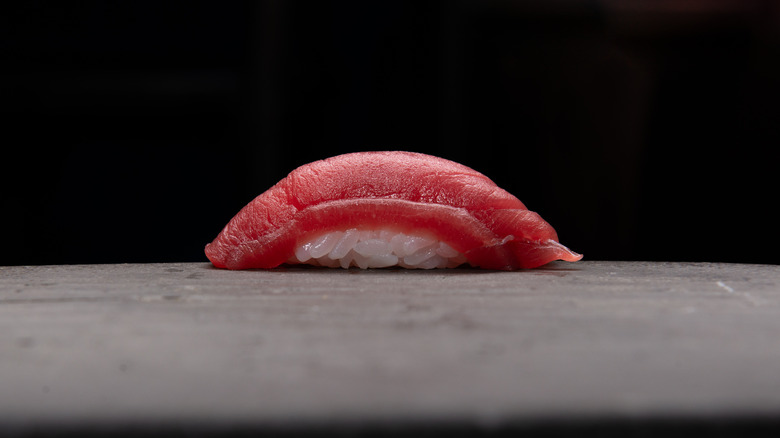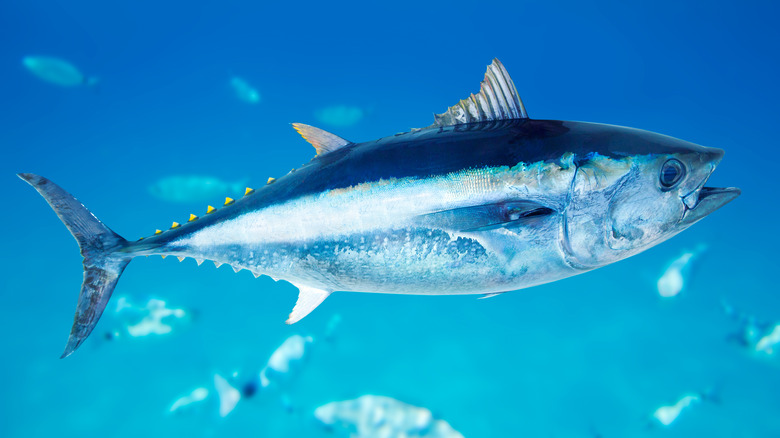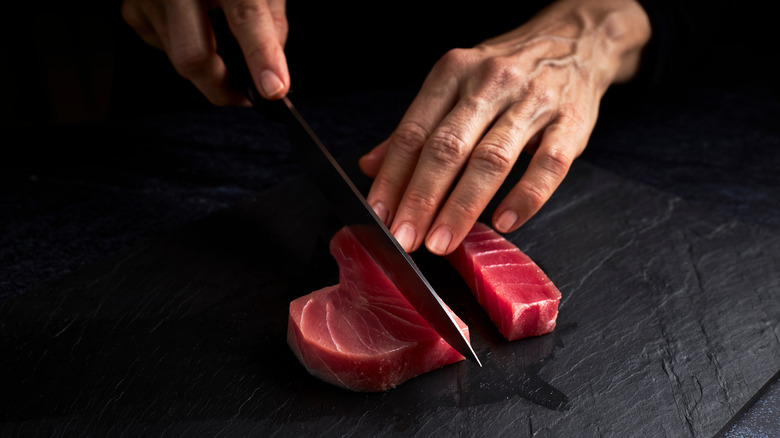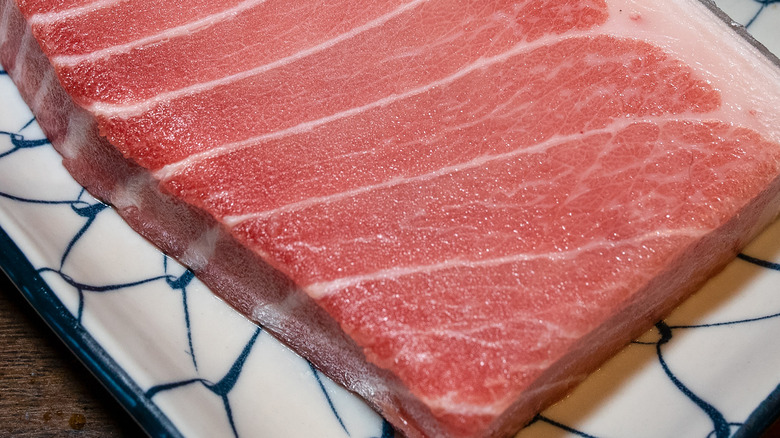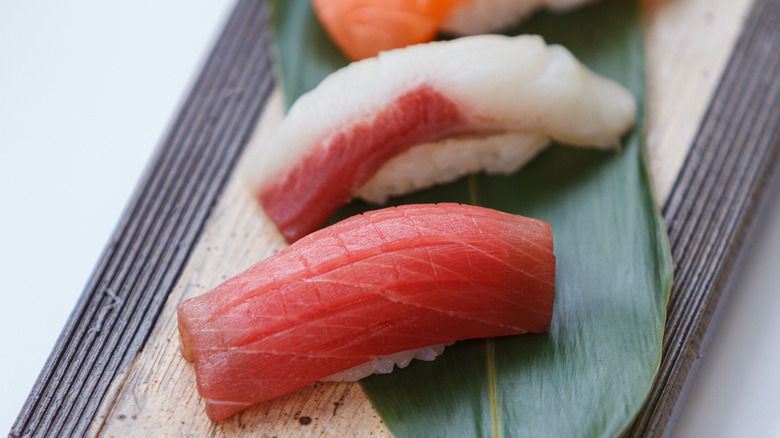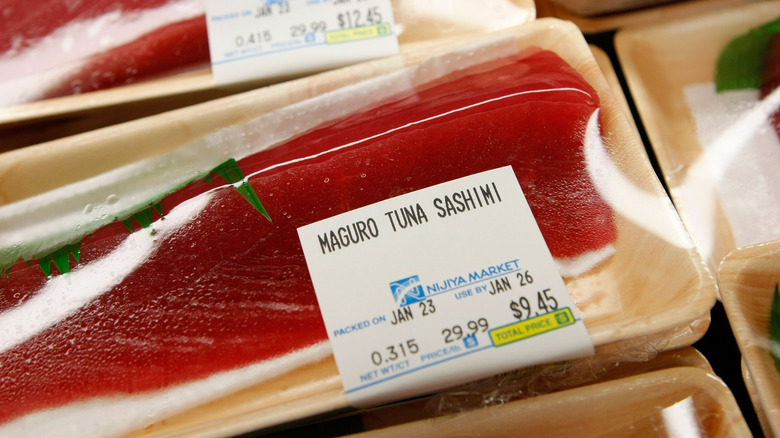Everything You Need To Know About Maguro
Sushi is one of Japan's greatest gifts to the world, right up there with anime, ramen, and Shohei Ohtani. It's been a signature of Japanese cuisine for over 1,000 years, working its way into national folklore. PBS recounts a legend that says that thieves were coming after an old woman's rice, so she hid it from them in an osprey nest. She returned much later to find the rice had fermented and mixed with fish scraps left over from the osprey's meal. While that may not sound particularly appetizing, she loved it, and sushi was born.
Of course, this is just an old wives' tale, but a few details stick out, namely the use of fermented rice. According to PBS, the earliest form of sushi contained not only fermented rice but also preserved fish, and was called nare-zushi, meaning "aged sushi." Interestingly enough, sushi likely originated with freshwater fish, specifically golden carp pulled from Lake Biwa. It's not the kind of thing you'd expect to find on sushi menus these days, which are dominated by ocean dwellers like tuna, eel, and sea urchin. Since they're typically served under their Japanese names, you might not know exactly what you're ordering, so let's catch you up on a critical term. It's something you're almost guaranteed to find at a sushi bar: maguro.
What is maguro?
Maguro is the Japanese term for bluefin tuna, and Japan Guide notes it's one of the most common fish found in sushi restaurants. Bluefin (scientific name: Thunnus Thynnus) are the biggest tuna, reaching lengths of six to 10 feet, per the World Wildlife Fund (WWF). The heaviest bluefin ever caught, according to the International Game Fish Association, was an astounding 1,496 pounds, snagged off the coast of Nova Scotia in 1979. Per the WWF, bluefin tuna have a global presence, found in every ocean, and they are divided into three species denoted by habitat: Pacific, Atlantic, and Southern tuna. They are remarkable hunters, built to maximize speed and equipped with the best vision of any bony fish.
According to NHK World-Japan, only a small portion of the bluefin tuna caught in Japan ends up being canned or cooked. The vast majority remains raw and is a staple of sushi restaurants. That's what you'll get if you order maguro off a menu. Taste Atlas notes that you'll often see it served as nigiri, the simple sushi style made with a little log of rice topped with fish. NHK World-Japan adds that maguro is a staple of sashimi platters, and can sometimes be found in donburi (served over a bowl of rice).
In the kitchen with maguro
The first step in preparing maguro is to fillet the whole fish. This is not something you can do at home, for myriad reasons. Firstly, you'd have to lug several hundred pounds of fish into your home. Furthermore, buying a whole bluefin tuna would put most people in debt. The BBC reports that the current record for the most expensive bluefin, sold in 2019, is $3.1 million. You also need to invest in special equipment to fillet a whole tuna, specifically a type of knife called a maguro-bocho. Per NHK World-Japan, the blade of a maguro knife can be as long as 150 cm, just shy of five feet. You can buy one from New York knifemaker Korin for a minimum of $1,300.
So, clearly, it's better to buy bluefin tuna that's already been butchered. There are two basic cuts of maguro: akami and toro. Japan Guide explains that akami is the dark red meat taken from the loins of the tuna. It is lean and firm to the tooth. Toro is the belly meat with a pink hue. It is much fattier than akami, with a rich, buttery flavor. JW adds that toro is the most prized and expensive cut. Due to its high fat content, it practically melts in your mouth.
Nutritional information
The nutritional profile of maguro depends on whether you're eating akami or toro. Akami is very lean and rich in protein. According to MyFitnessPal, one ounce of akami sashimi contains 41 calories. 68% of those calories come from protein, while the other 32% comes from fat. It contains no carbohydrates. As for Toro, MyFitnessPal has it at 60 calories per ounce, with 45% of those coming from protein and 55% coming from fat.
The fat content of toro might alarm you at first, but Healthline notes that most of the fat in tuna comes from omega-3 fatty acids, which are essential nutrients for our hearts and brains. It also has a robust vitamin and mineral content. One potential health concern associated with maguro, and all kinds of larger tuna species for that matter, is that they often contain traces of mercury. Eating too much raw tuna could lead to mercury poisoning.
Maguro vs. Ahi vs. Hamachi
In addition to bluefin tuna, you'll also see yellowfin tuna on many menus. It is often referred to as ahi tuna, a name derived from the Hawaiian word for fire (via Go Fish'n Online). Yellowfin is smaller than bluefin tuna, but Ocean Info notes that it can still reach an impressive weight of 400 pounds while possessing the characteristic streamlined body we see with bluefin tuna. Unlike maguro, it's quite common to cook ahi, albeit just a little bit. It is typically served with a seared exterior and raw interior.
You'll often see hamachi alongside maguro on sashimi plates. MasterClass reveals that hamachi comes from young yellowtail fish, and this is where we encounter a bit of linguistic confusion. San Diego fishmonger Catalina Offshore Products notes that yellowtail is often listed on menus as "yellowtail tuna," but this is a misnomer. Yellowtail is actually a type of amberjack. Per MasterClass, there are three basic kinds of yellowtail: greater amberjack, gold-striped amberjack, and Japanese amberjack. Sashimi is typically made from Japanese amberjack, also known as "buri." There is no such thing as "yellowtail tuna," so watch out for this error on menus.
Where to buy maguro
Maguro isn't hard to find. You can find it in just about every sushi bar on the face of the planet. NHK World-Japan goes as far as to call maguro "an essential component of any sushi meal, whether in Japan or around the world." If you want to make your own sushi at home, look for a specialty fish market. The most famous example would have to be the Tsukiji market in Tokyo, which supplies many of the finest sushi bars in the city. But NHK World-Japan notes that bluefin is an international food, so you should be able to find some at a market near you.
There is some debate as to whether buying maguro is appropriate at all, due to environmental concerns. According to the Center for Biological Diversity, decades of overfishing have made the Atlantic bluefin tuna and Southern bluefin tuna critically endangered. In the United States, the National Oceanic and Atmospheric Administration (NOAA) has responded by tightening regulations on tuna fishing, including implementing catch limits (via the Federal Register). Efforts appear to be making a difference, as National Geographic reported in 2021 that the International Union for Conservation of Nature (IUCN) removed Atlantic bluefin tuna from its Red List of Threatened Species and changed the Southern bluefin's status from critically endangered to endangered. It's extremely encouraging; we just have to accept a little less bluefin at the market.
